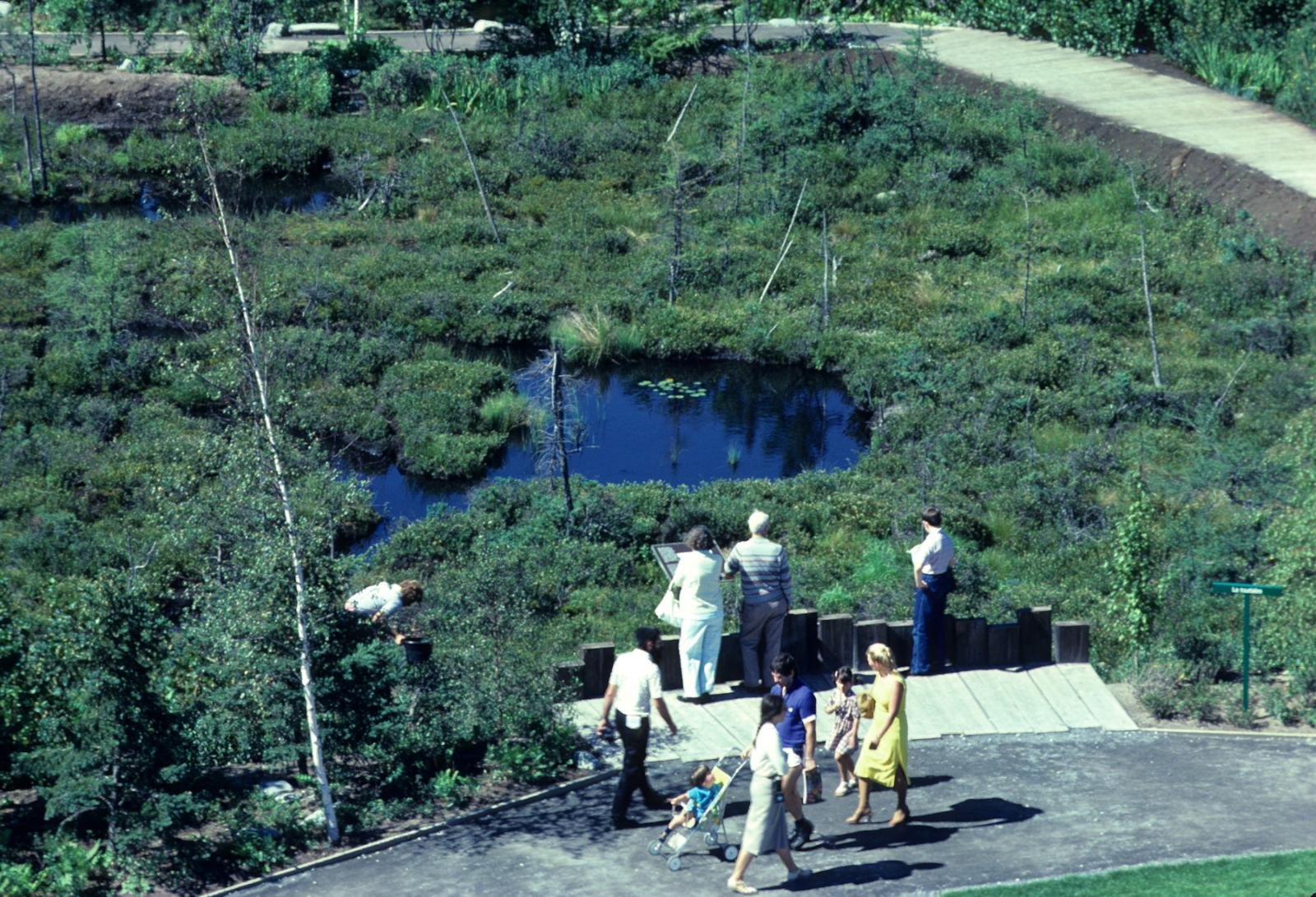Urban Mires: What Happened to the Garden of Moss?
21 août 1980. Credits: Réal Benny. Source: Archives Montréal (https://archivesdemontreal.ica-atom.org/uploads/r/ville-de-montreal-section-des-archives/2/1/210045/VM94-B253-006.jpg)
BY ISABELLE BOUCHER
“Man and Nature bloom anew at Man and His World.”
Montreal is a city animated by a lingering cosmopolitan phantasmagoria, especially its two ‘man-made’ islands, Île Sainte-Hélène and Île Notre-Dame. Built to host Expo 67, a colossal World’s fair resting on dredged soil and urban debris, they became the experimental landscape and socio-technical matrix of the future megacity Montreal dreamt of being. This event crystallized the city’s image as the avant-garde “capital of the megastructure,” a concept which redefined (urban) spaces as dynamic relationships between people, technology, and dwellings, “coded not necessarily in architectural terms but rather by notions of process” akin to those of the organism (Riar 2020, 200). Thirteen years later, the Floralies Internationales de Montreal was held in the wake of “Man and his World,” the fair’s permanent exhibition on Île Notre-Dame. The 8th International Horticultural Exhibition invited citizens to admire “the world’s most beautiful botanical garden” representing the cultures of twelve nations, including Canada. While the World’s fair's progress-driven themes emphasized mankind’s innovations in communications and resource management technologies (Riar 2020, 197), the horticultural event rather appealed to the visitors’ senses to communicate various traditions and disseminate knowledge about the “vital links that exist between man and nature” (Man and His World 1980, 80). The organizers viewed the gardens as “soft technologies,” designed to beautify the city while benefiting its economic and cultural sectors. Gardening now set the relations between Man and Nature, as a form of “environmental stewardship that would make life in the city better for everyone” (Despard 2020, 17).
Thinking with Natasha Myers, I understand gardens as infrastructures that offer “profound insights into forms of governance, political economy and ecology, industry, labor, and more” (2019, 125). They are “sites where people explicitly stage and restage their relationships with nature” (ibid.) and, as cultural artifacts, they dictate “how one should appreciate these forms of life as beautiful, healing, nourishing, exotic, dangerous, economically productive, or ecologically significant” (ibid.). Gardens not only inform what city dwellers find valuable and good, they organize the political and economic relations urban centers cultivate—or not—with their peripheral others—rural lands, ‘nonhuman’ life and ‘nonlife’. Botanical gardens, such as the Floralies—which have long been tied to the imperatives of colonial expansion (Baber 2016)—are not merely displays of state power and scientific knowledge, but technologies of extraction that operate by transplanting alien ecological—so-called rural—habitats into the hybrid spaces of a metropolis. And while we could frame this dynamic within urban/rural or center/periphery binaries, I contend that what made the Canadian garden a garden in 1980 was precisely its relationship to what lies far beyond the theoretical scope of such binaries—that which eludes rigid biological and geographical inscriptions: wetlands. What follows is a meditation about murky and precarious dwellings. And about binaries, and the relentless oscillations that govern places of belonging. It is an invitation to consider urban and rural geographies and all that lies beneath and beyond their preference for the living. And it is the story of a northern peat bog that was “transplanted” to Île Notre-Dame in 1979.
“A little bit of James Bay in Montreal”
It took a fleet of trucks fifty 36-hour trips to haul half an acre of James Bay to Montreal. That “little bit” of Northern Quebec was more precisely 1300 frozen blocks of peat taken from the Hélène Lake bog, near the construction site of the LG2 hydroelectric project. The blocks, 1.2 x 1.2 m and 30 to 50 cm thick, were then reassembled on top of layers of polyethylene, sand, and commercial peat, forming a 2000 m² pond. To ensure that the Notre-Dame peat bog bloomed in time for the Floralies, a year later, gardeners carefully monitored water and acidity levels, frequently “watering” it with the St. Lawrence river’s tainted water and even using sulfuric acid to lower its PH (Pellerin et al. 2015, 5). The garden's “spongy consistency,” created by a combination of sphagnum mosses, tamarack, black spruce, hairy honeysuckle, round-leaved sundew, and Labrador tea, amongst 50 northern species, could be admired for the first time in Montreal’s temperate climate, a stark contrast to the hydrogeoclimatic conditions of James bay, 1500 km away (ibid., 11; Press Kit of the Floralies 1979). In 1980, thirteen years after Expo 67, the bog was fully integrated as yet another dynamic process in the city’s “organic” megastructure.
1980. La tourbière des Floralies (Floralies’ Peat Bog) Source: Archives du Jardin botanique de Montréal
Why did the chief horticulturist of the Montreal Botanical Garden choose to represent the “nation” with a northern peat bog? Because Canada was, and still is, home to a quarter of the world's wetlands, which had already been massively drained for agriculture and urban sprawl. The garden's purpose was to bring the ecological benefits of these threatened ecosystems to an emerging environmental awareness. Montreal, which used to be completely surrounded by “swamps and boggy places” (Dagenais & Feldstein 2017, 51) considered unsanitary in the 19th century, destroyed much of the riparian wetlands in the St. Lawrence Lowlands, eliminating 80% of its marshes (Beck & Littlejohn 2014, 140). The stinging irony is that manufacturing the islands for Expo 67 “was one of the single most damaging projects” for the surrounding wetlands (ibid.). So how could they be celebrated as part of a national heritage?
“From the Barren Lands to Man and His World”
“Canada is the wetlands settler country par excellence” (Giblett 2014, 11), as, much like Montreal, most of its early settlements were built alongside marshes. Its colonial literature has long portrayed these places as murky, monstrous, and ominous. In the dominant cultural paradigm, marshes were seen as wastelands, which licensed industries to dump toxic waste in their waters or to drain them (35). Seen as dead and inauspicious lands, swamps, marshes, and bogs posed a threat to colonial powers, while being particularly difficult to map, as water and land were inextricably linked. Peat bogs especially are dense and viscous worlds where mosses thrive on top of their own decaying shroud, a process reaching back into the Carboniferous era “when swamps ruled the earth” (203). What is Montreal’s garden of moss in relation to these processes? What is it trying to do, and for whom? Is it really bringing ancestral “barren lands” back to life and into the city of the future?
Geopolitics are, in Kathrin Yusoff’s view, fundamentally rooted in an ontological and racial division between life and nonlife. This privileges an active, biocentric notion of subjectivity constituted in opposition to inhuman and fungible matter (Yusoff 2018, 71). Yusoff considers how geology’s grammar of extraction enabled the “territorial and psychic dispossession” (90) of Indigenous communities, disrupting their relationships to places of belonging by transforming lands into abstract maps of resources (83) and, I might add, into gardens. I situate botany’s biocentric taxonomy within the same epistemic legacy, conspiring with Geology to extract literal “bits” of lands from the Cree territories of Eeyou Istchee. Because gardens epitomize life, transplanting an ambiguous landscape of living and non-living processes served to regulate its ontological status as a thriving and living urban wetland. This story of a garden made of moss not only reveals how Montreal discredited the way the Cree community valued and used wetlands, but offers insight into the colonial governance of Canada and Quebec. For these colonialist entities, environmental awareness could only be displayed through further dispossessing an Indigenous community already impacted by Quebec’s LG2 hydroelectric project (Sénécal & Égré 1999). In other words, by celebrating Canada's northern ecosystems, Montreal and its Floralies contributed to the erasure of its colonial foundations by conflating a ‘life worth preserving’ with urban life.
Ultimately, representing peat bogs as “barren lands” speaks to the political figuration of all that is not urban, or, in Giorgio Agamben’s words, as bare life, which, in Western politics, “has the peculiar privilege of being that whose exclusion founds the city of men,” ordered by the “good life” (Agamben 1998, 7). To be preserved, the elusive and ominous peat bog had to be transplanted to the city, where it could be a tamed vehicle for environmental values. Rethinking geographies beyond anthropocentric and biocentric views of what defines urbanities and ruralities, might allow us to better understand the constitutive exclusions that created this binary in the first place. In Canada, both urban centers and rural regions have been constituted through the destruction of wetlands. This was repeated in the 1980s, when, just two years after the Floralies championed the city’s green turn, the Notre-Dame peat bog was abandoned. Today, if you were to go there, you would find a dried-out pond, where meridional species have reclaimed their rights. But perhaps its disappearance from the city's landscape is a sign that wetlands remain unsettled and unsettling.
Editor’s note: This article was edited on April 20, 2023, adding two higher-quality images, and removing a poetic epigraph
Works Cited
Agamben, Giorgio. 1998. Homo sacer: Sovereign power and bare life, trans. D. Heller-Roazen. Stanford, CA: Stanford University Press.
Baber, Zaheer. 2016. “The Plants of Empire: Botanic Gardens, Colonial Power and Botanical Knowledge.” Journal of Contemporary Asia 46 (4): 659–79.
Beck, Gregor Gilpin, and Bruce Litteljohn. 2014. Voices for the Watershed: Environmental Issues in the Great Lakes-St Lawrence Drainage Basin. Montréal & Kingston: McGill-Queen’s University Press.
Dagenais, Michèle, and Peter Feldstein. 2017. Montreal, City of Water: An Environmental History. Nature, History, Society. Vancouver, British Columbia: UBC Press.
Giblett, Rod. 2014. Canadian Wetlands: Places and People. Bristol, UK; Chicago: Intellect.
Man and His World 80. 1980. “Man and Nature Bloom Anew at Man and His World.” Accessed October 19, 2022. https://www.worldsfairphotos.com/expo67/man-and-his-world/1980-brochure.pdf.
Pellerin, Stéphanie, Vincent Arricastres, Lauriane Long-Raymond, and Martin Lavoie. 2015. “La tourbière relocalisée de l’île Notre-Dame : un exemple de mesure de compensation en avance sur son époque.” Le Naturaliste canadien 139 (2): 4–13.
Senécal, Pierre, and Dominique Égré. 1999. “Human Impacts of the La Grande Hydroelectric Complex on Cree Communities in Québec.” Impact Assessment and Project Appraisal 17 (4): 319–29. https://doi.org/10.3152/147154699781767648.
Riar, Inderbir Singh. 2020. “Montreal and the Megastructure, ca 1967.” In Expo 67: Not Just a Souvenir, edited by Rhona Richman Kenneally and Johanne Sloan, 193–210. Toronto: University of Toronto Press.
Yusoff, Kathryn. 2018. A Billion Black Anthropocenes or None. Minneapolis: University of Minnesota Press.
Isabelle Boucher (MA Philosophy) is a PhD student in Communication Studies at Concordia University. Situated at the intersection of feminist STS, energy humanities, and political ecology, her research project examines the epistemic legacies, the cultural assumptions, and the knowledge politics of Earth System Science (ESS), and specifically how this framework, rooted in cybernetics, understands and articulates the concepts of sustainability, clean energy, and circular economy. Isabelle questions how ESS informs global and local renewable energy and sustainability narratives, policies, and infrastructures, and seeks to uncover its underlying assumptions about "the Earth," without ignoring the complexities and critical potential of this science in the context of climate change mitigation strategies. By triangulating energy grammars, sustainability discourses, and power structures according to ESS (neo-)colonial histories and scientific experiments, she highlights the critical intersection of environmental and social justice issues and argues for the importance of epistemic justice at the heart of decolonial energy and sustainability imaginaries. She recently collaborated with Professor Liz Miller on a creative research project about the environmental and colonial histories of Montreal's Notre Dame and Sainte Hélène islands. As part of that project, she was the lead author of a segment of the WasteScapes locative app. Isabelle is currently a member of Concordia’s Milieux Institute and its student-run Solar Media Collective, as well as a research assistant for the Institute’s Ethnography Lab and for her supervisor Krista Lynes.


